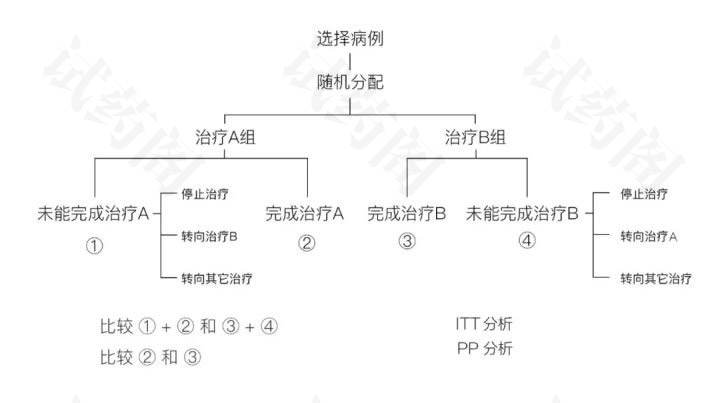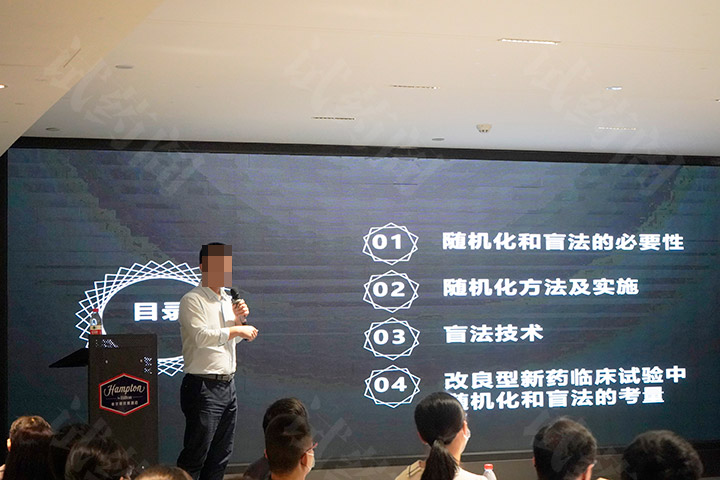
ITT(Intention-to-Treat)分析原则是指,将临床试验中所有被随机分组的患者纳入分析,即使他们在研究期间未完全遵守研究方案或者在随访期间退出了研究。这种分析方式可以更好地反映真实临床情况,避免数据偏差,提高临床试验的可靠性和科学性。
临床试验工作者追求完美的临床试验,但现实中没有完美无错的情况。在任何临床试验中,都可能出现差错和错误,例如,受试者随机后发现不符合入选标准或吃错药入错组等。当这些与随机有关的错误出现时,应该采取什么措施?
随机对照双盲临床试验是验证药物和器械安全有效的金标准。然而,在实施过程中,由于时间、资源、医疗环境等因素的限制,临床试验实施的过程中会出现各种各样的问题甚至错误。
如何避免和减少系统性错误和人为错误的发生,方案中最好能事先考虑并且给出出错后应该采取的措施。即使事先尽最大努力考虑到了可能发生的错误,并且在实施过程中尽最大努力避免错误的发生,但是错误还是有可能发生,那么发生之后遵循什么原则来处理,以及采取什么措施是降低错误对试验影响的关键。
在临床试验中,如何预防和减少系统性和人为错误的发生是非常重要的。需要提前考虑可能出现的错误,并制定相应的应对措施。即使在试验实施过程中尽最大努力避免错误的发生,但错误仍有可能发生。因此,应遵循一些原则来处理错误,降低错误对临床试验的影响。
临床试验中随机非常重要,有很多文章和书详细介绍随机方法(分层区组随机,动态随机等)以及如何实施,但是罕有介绍随机出错时怎么处理以及如何预防(比如,填错Baseline信息导致分错组,Study ID是1221的受试者被错误的分配了1212编号的药物等等)。
出错不可怕,可怕的是没有事先预防计划以及定好出错后的处理措施。在科学合理的设计好随机方法后,一份详细的随机化实施计划、一份详细的随机化Review和Check表、一份详细的预防随机化出错方案、一份随机化实施过程中出错后的解决措施以及统计分析策略计划,是降低随机化出错以及出错后能及时采取科学措施的关键。本文主要介绍下随机化从出错后的处理原则和处理措施。

ITT原则
随机对照临床试验,FDA, EMA以及中国药监局都推荐遵循ITT原则。什么是ITT原则?请看ICH E9给出的定义:
The principle that asserts that the effect of a treatment policy can be best assessed by evaluating on the basis of the intention to treat a subject (i.e. the planned treatment regimen) rather than the actual treatment given. It has the consequence that subjects allocated to a treatment group should be followed up, assessed and analysed as members of that group irrespective of their compliance to the planned course of treatment.
解读:
- 不管受试者实际上吃了哪个药到了哪个药物组,在分析时按照原计划分入哪个组来分析。例如,某受试者原计划分入A组吃A药,实际上错误的进入了B组吃了B药,那么分析时把这个人归原计划的A组。这样做有什么好处?假如A是试验药,B是安慰剂,试验目的是证明试验药优于安慰剂。那如果受试者原计划是分入试验药组实际服用了安慰剂,在分析时把受试者纳入原计划的试验药组,其实是拉低了试验药组的治疗效果;如果受试者原计划是分入安慰剂组实际服用了试验药,在分析时把受试者纳入原计划的安慰剂组,实际上是拉高了安慰剂组的治疗效果。那么,在这种情况下,如果最后的结果显示试验组疗效优于安慰剂组,那更能说明试验组优于安慰剂组。本质上而言,对于优效试验,ITT原则是保守性原则。但是,对于非劣和等效试验,ITT并不保守,所以此时一般采用PPS作为主分析集。
- 不管受试者实际上是否依从预期的治疗,都应该纳入分析。例如,某受试者服用试验药物期间又服用了方案中不允许的其他药物、或中途退出、或出现了方案偏离等,这些受试者不应该随意剔除,根据ITT原则,应该纳入分析。
可见ITT原则的核心是尽量保留随机后的受试者纳入最后的分析数据集进行分析,而且是按照原计划的入组来分析。为什么这么做?ITT原则按照原计划执行分析,主要是考虑到试验组和对照组保持平衡。如果按照实际的情况来分析,可能会打破随机化保持的平衡。实际场景中,在有些情况下譬如有受试者随机后发现其不符合入选标准或有些受试者随机后没有接受服用任何药物,这样的受试者经过讨论可以剔除,这也就是对ITT原则进行调整,形成了Modified ITT数据集。
ITT原则对于随机化出错采取什么措施有指导意义吗?
随机化出错时,ITT原则是处理出错的重要参考依据。面对随机化出错问题,不要着急忙慌,要根据ITT原则进行合理分析,尽量保持按照原计划入组分析,尽量不要从分析中剔除,这样才能发挥随机化的优势:保持组间平衡。
案例
- 案例1
In a placebo controlled trial, consenting participants were assigned the next available study ID and corresponding treatment allocation from the randomisation schedule and issued a bottle pre-labelled with their study ID that contained either active or inactive capsules, as appropriate. A participant assigned study ID 3113 was mistakenly given the bottle labelled 3133. The error was discovered several weeks after treatment had commenced, when a new participant was assigned study ID 3133 and the corresponding bottle could not be located. A staff member attempted to fix the error by giving the second participant the bottle labelled 3113. Unfortunately, the affected study IDs were associated with different treatment allocations and the switching of study IDs made the problem worse, since both participants received the incorrect treatment. Such crossover between treatment groups is problematic, as it can reduce the estimated treatment effect under an ITT analysis.2 Had the staff member reported the error when it was discovered, a new bottle containing capsules from the correct treatment group could have been prepared for the second participant, and only the first participant would have received the incorrect treatment.
- 案例2
In a blinded trial employing stratified randomisation with randomly permuted blocks, a participant belonging to stratum A was incorrectly assigned the next available study ID (8014) and corresponding treatment group from stratum B. Before the participant received any treatment, a staff member reported the error and requested the incorrect randomisation be undone by releasing study ID 8014 to be reassigned to the next participant belonging to stratum B, allowing the affected participant to be re-randomised correctly in stratum A. By the time this request was received by the coordinating centre, another participant had been randomised in stratum B. This raised questions about what should be done with study ID 8014 if released as suggested. Reallocating this ID to the next participant randomised in stratum B would cause the randomisations in this stratum to become non-sequential, making the randomisation records difficult to audit. Conversely, skipping study ID 8014 would create a gap in the randomisation schedule, interfering with the blocking and potentially introducing imbalance in the number of participants randomised to each group. In either case, a systematic deviation from the intended randomisation sequence would occur, which was deemed unlikely to introduce bias but could harm trial credibility. Had the trial been open-label, reallocating study ID 8014 would have been even more problematic due to the lack of allocation concealment following the initial randomisation. Fortunately, the trial investigators decided to maintain the initial randomisation for the participant, thus avoiding any further problems due to the initial error.
建议
出错后,不要试图去改过来这个错或者通过调整后边的受试者入组来降低这个错误的损失。出错后,最好是详细记录下来这个出错的受试者信息以及出错的详情,然后避免后续类似错误发生。下面给出几种出错情况和措施:
- 受试者随机时输入了错误的basline信息导致随机出错(例如,生日时间提供的是年月时间导致年龄信息算错,最终导致baseline信息错误)
措施:接受错误的随机,并且记录下准确的baseline信息。分析时按照原计划应该分入到的组别。
- 随机后的受试者发现不符合入选标准
措施:除非有事先定好的客观无偏见的剔除标准,否则应该把该受试者保留在试验中并且继续收集完整的信息,按照ITT原则纳入数据集进行分析。
- 受试者入错组服错药
措施:把受试者保留在试验中,继续收集试验信息。分析时把受试者放入原计划入的组来分析。
- 受试者多次随机
措施:
- 如果是多次随机间隔时间不长,多次错误随机和第一次随机采集的baseline信息应该是相同的,此时记录下来多次随机信息,在纳入分析时用第一次的随机信息即可;
- 如果多次随机隔了多天,那多次随机采集的baseline信息可能不同,此时记录下来多次的随机信息。第一次随机后的多次随机是错误的随机,情况类似于随机后的受试者发现不符合入选标准。
写在最后
没有完美的临床试验,我们在实际工作中遇到各种各样的问题甚至随机错误,在随机出错后尽快给出合理的解决措施能最大程度降低错误对试验的影响。采取什么样的解决措施,等到服务发生时再考虑会让人措手不及着急忙慌,在做试验之前在方案和计划里提前预想可能出现的错误以及解决措施可以让我们在试验过程中遇到错误时不着急忙慌、稳妥处理。相信大家都有类似体会,在做一件复杂的事情前,把可能的问题、差错和办法都想好了,那么做事情事我们就更有信心、更沉着稳重、更不容易出错了。虽然我们不可能想到所有的可能,但是事先努力去想各种可能这一举动能让我们胸有成竹即使在过程中遇到新的可能也知道用什么原则来处理然后及时给出处理措施。计划不是万能的,但是没有计划是把事情搞砸甚至失败的很重要的原因。
在临床试验中,如果按照ITT原则进行数据分析,可以更好地反映实际治疗效果,而不是只考虑实验组中那些完全遵循研究方案的患者。因为在实际临床情况下,患者可能会因为各种原因无法完全遵循研究方案,例如药物不良反应、遗传因素、个体差异等。
通过ITT分析,可以更好地反映治疗效果在实际应用中的真实情况,避免人为地影响结果。因此,ITT原则是临床试验数据分析中一个非常重要的原则。
参考文献
Yelland LN, Sullivan TR, Voysey M, Lee KJ, Cook JA, Forbes AB. Applying the intention-to-treat principle in practice: Guidance on handling randomisation errors. Clinical Trials 2015; 12(4): 418–423.
Ke CL, Wang JM, Zhang C, Jiang Q, Snapin S. On errors in stratified randomization. Statistics in biopharmaceutical research 2017; 9(2): 225-233.
Yelland LN, Kehan BC, Dent E, Lee KJ, Voysey M, Forbes AB, Cook JA. Prevalence and Reporting of Recruitment, Randomisation and Treatment Errors in Clinical Trials: A Systematic Review. Clinical Trials 2018;15(3):278-285.

 关注微信公众号
关注微信公众号
